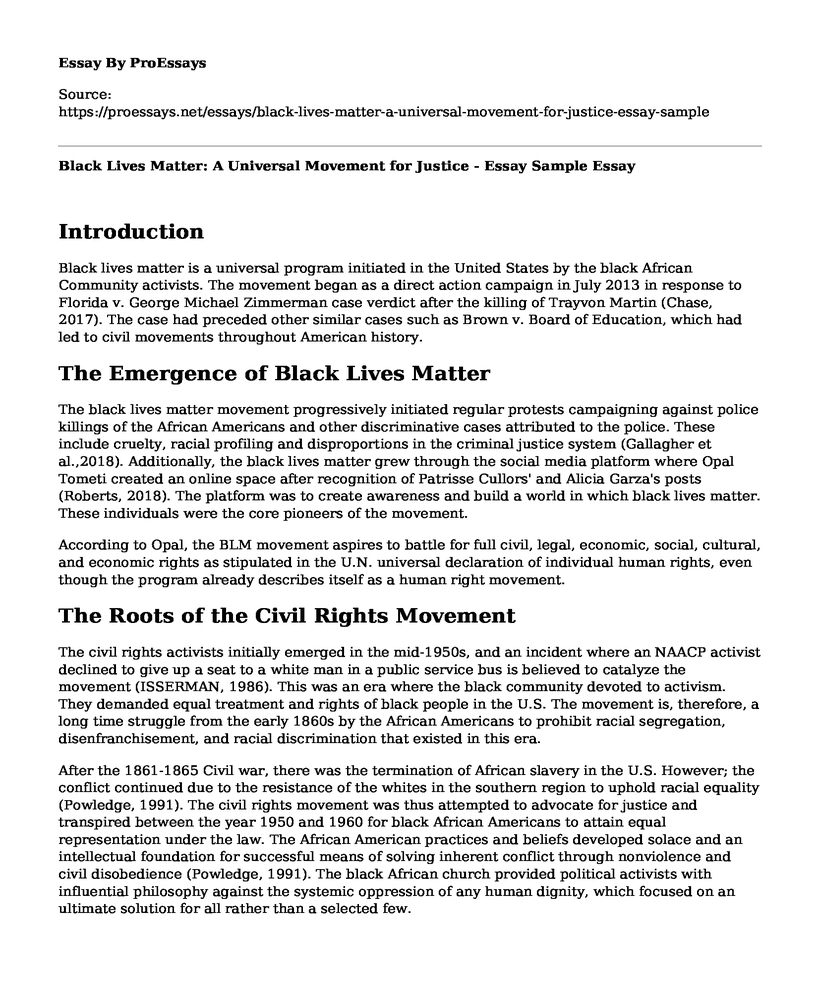Introduction
Black lives matter is a universal program initiated in the United States by the black African Community activists. The movement began as a direct action campaign in July 2013 in response to Florida v. George Michael Zimmerman case verdict after the killing of Trayvon Martin (Chase, 2017). The case had preceded other similar cases such as Brown v. Board of Education, which had led to civil movements throughout American history.
The Emergence of Black Lives Matter
The black lives matter movement progressively initiated regular protests campaigning against police killings of the African Americans and other discriminative cases attributed to the police. These include cruelty, racial profiling and disproportions in the criminal justice system (Gallagher et al.,2018). Additionally, the black lives matter grew through the social media platform where Opal Tometi created an online space after recognition of Patrisse Cullors' and Alicia Garza's posts (Roberts, 2018). The platform was to create awareness and build a world in which black lives matter. These individuals were the core pioneers of the movement.
According to Opal, the BLM movement aspires to battle for full civil, legal, economic, social, cultural, and economic rights as stipulated in the U.N. universal declaration of individual human rights, even though the program already describes itself as a human right movement.
The Roots of the Civil Rights Movement
The civil rights activists initially emerged in the mid-1950s, and an incident where an NAACP activist declined to give up a seat to a white man in a public service bus is believed to catalyze the movement (ISSERMAN, 1986). This was an era where the black community devoted to activism. They demanded equal treatment and rights of black people in the U.S. The movement is, therefore, a long time struggle from the early 1860s by the African Americans to prohibit racial segregation, disenfranchisement, and racial discrimination that existed in this era.
After the 1861-1865 Civil war, there was the termination of African slavery in the U.S. However; the conflict continued due to the resistance of the whites in the southern region to uphold racial equality (Powledge, 1991). The civil rights movement was thus attempted to advocate for justice and transpired between the year 1950 and 1960 for black African Americans to attain equal representation under the law. The African American practices and beliefs developed solace and an intellectual foundation for successful means of solving inherent conflict through nonviolence and civil disobedience (Powledge, 1991). The black African church provided political activists with influential philosophy against the systemic oppression of any human dignity, which focused on an ultimate solution for all rather than a selected few.
Challenges of Legal Segregation and Jim Crow
The system of legal segregation under Jim Crow was the most problematic throughout the southern and suppressed black political progress (Powledge, 1991). Through this period, the black American leaders constantly constructed institutional and intellectual capital that would promote civil rights in the mid to late 20th century (ISSERMAN, 1986). After a consistent struggle, President Johnson's society introduced new roles for the national government as solutions to racial discrimination. These protected the civil and political rights of the black community and promoted economic and social justice.
Both movements focus on a particular race and with an analogous objective which is equal treatment of black people. Additionally, both have quantitatively amounted to a measurable influence on the legal and political landscape. However, unlike the civil rights area of focus, the BLM is the human rights movement and hence focuses on fundamental reordering the society other than changing specific laws (Roberts, 2018). The civil rights movement advocated the prohibition of legal, social, cultural, and political change and end of segregation. At the same time, the BLM fights against universal racism and violence experienced by the black American society.
Conclusion
Through the civil rights movement, the Southern blacks gained equal access to leadership resources and public accommodation and electoral process and a new concept of themselves. Racial equality under the law granted the Black community legal protection and promoted their dignity in the white-dominated world. The BLM movement has as well contributed to the ousting of high profile corrupt prosecutors and police and restructuring of the national platform to include the criminal justice reform issues.
References
Chase, G. (2017). The Early History of the Black Lives Matter Movement and the Implications Thereof. Nev. L.J., 18, 1091.
Gallagher, R. J., Reagan, A. J., Danforth, C. M., & Dodds, P. S. (2018). A divergent discourse between protests and counter-protests: # BlackLivesMatter and# AllLivesMatter. PloS one, 13(4).
ISSERMAN, M. (1986). THE ORIGINS OF THE CIVIL-RIGHTS MOVEMENT-BLACK-COMMUNITIES ORGANIZING FOR CHANGE-MORRIS, A.D. https://kinginstitute.stanford.edu/sites/mlk/files/03_02_br_carson.pdf
Powledge, F. (1991). Free at last: The civil rights movement and the people who made it (p. 620). Boston, MA: Little, Brown.
BIBLIOGRAPHY Roberts, F. L. (2018, July 13). How Black Lives Matter Changed the Way Americans Fight for Freedom. https://www.aclu.org/blog/racial-justice/race-and-criminal-justice/how-black-lives-matter-changed-way-americans-fight
Cite this page
Black Lives Matter: A Universal Movement for Justice - Essay Sample. (2023, May 22). Retrieved from https://proessays.net/essays/black-lives-matter-a-universal-movement-for-justice-essay-sample
If you are the original author of this essay and no longer wish to have it published on the ProEssays website, please click below to request its removal:
- Essay Example on Video Gaming
- Reaction Paper: Black Men and Public Space
- The False Comfort of Securing Schools - Article Analysis Essay
- Hate Groups and Extremism Essay Example
- Avoiding Violence Between Police and Citizens - Essay Sample
- Essay Sample on Texas on the Brink: Economic Policies to Reduce Poverty
- Women in Ancient Greece & India: A Comparison - Research Paper







